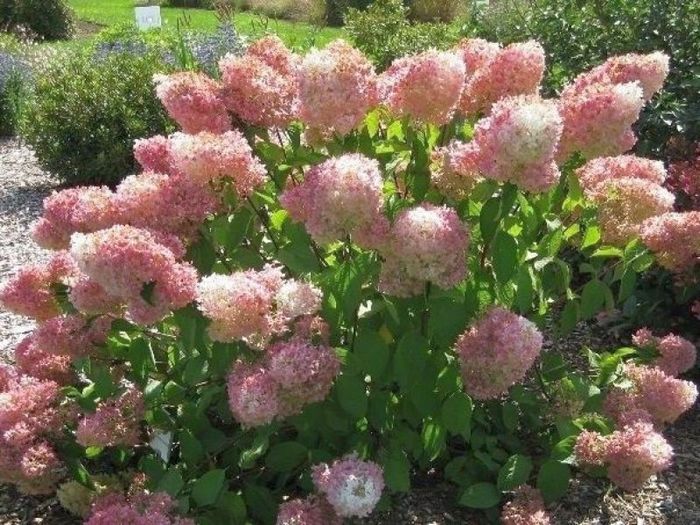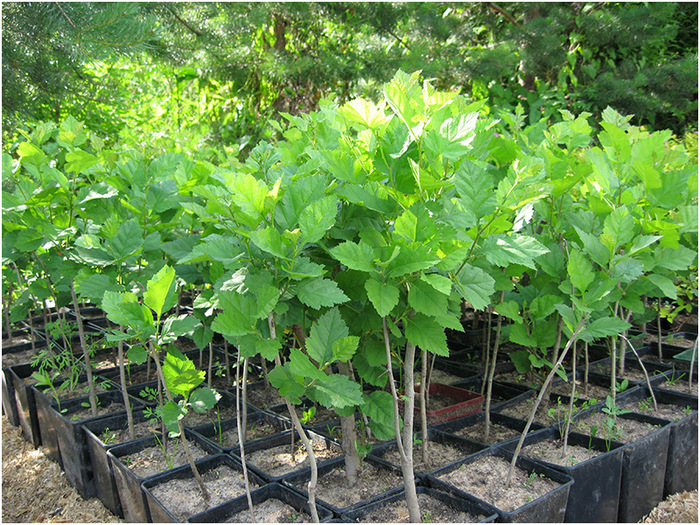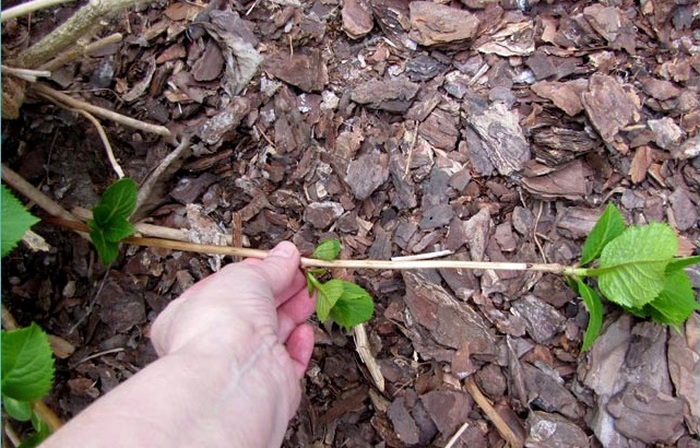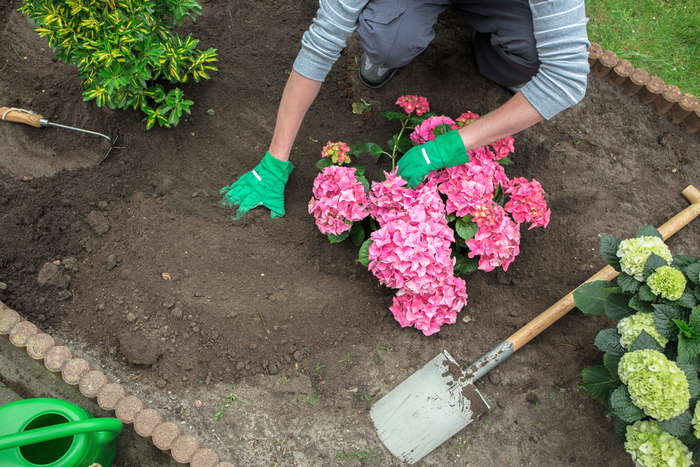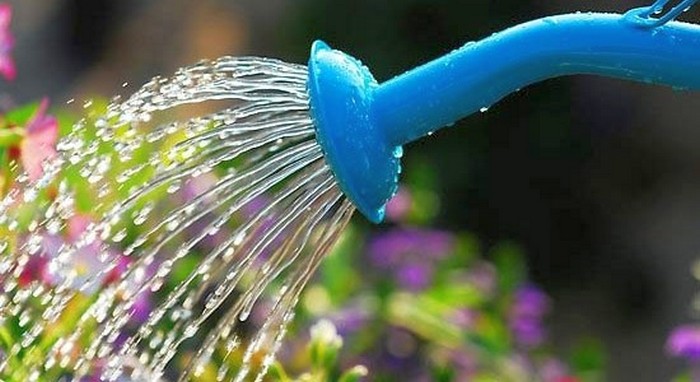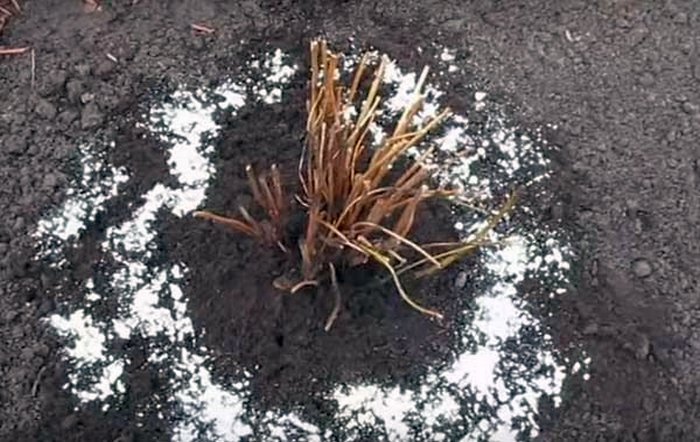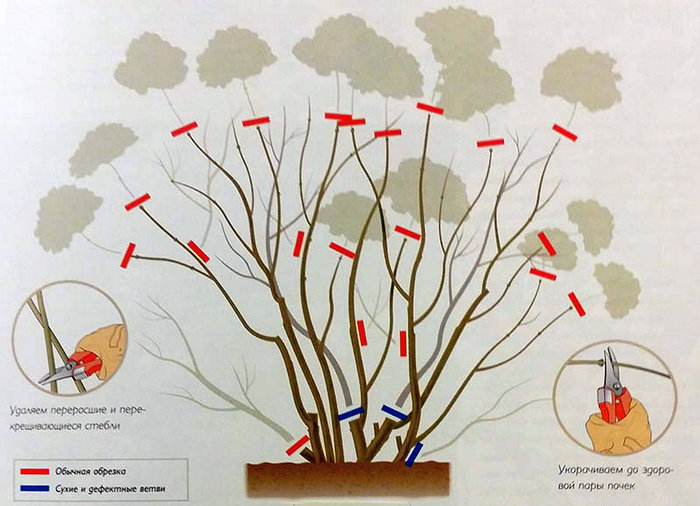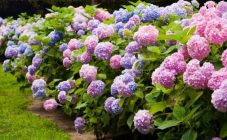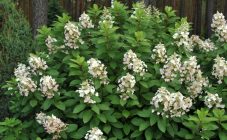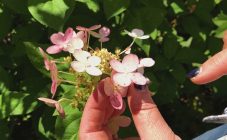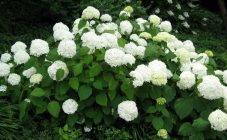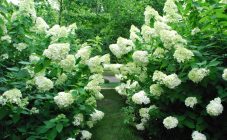Content:
Hydrangea is an unusually beautiful ornamental plant. Hydrangea Magic Sweet Summer has its own characteristics. An ornamental spherical bush looks amazing even without flowers. And large, like inverted grape bunches of panicle inflorescences adorn the flower all summer.
Description of the variety
The homeland of the panicle hydrangea is the Netherlands. The variety was created in the nursery in the town of Boskop in 2006. In 2013, hydrangea Magical Sweet Summer was awarded a silver medal at the PLANTARIUM exhibition, Boskoop, Netherlands.
This compact bush grows up to 1.5 meters and has a voluminous spherical crown. Large conical panicles (up to 13 cm in height) inflorescences in an upright position are located throughout the shrub.
The inflorescences of this hydrangea are non-pollinated or almost sterile, only in the depths of the bunch there are a small number of fruiting flowers. At the beginning of flowering, the inflorescences are colored light green, then beige, and at the end of flowering they acquire pale pink tones. The simultaneous presence of all these shades on the inflorescences looks impressive. Flowering lasts almost three months - from July to October.
Oval-elongated leaves also change color during the season: green at the beginning of summer, towards autumn they acquire a purple hue.
Hydrangea in winter
This variety is quite hardy. Can hibernate without shelter. If the bush is young, it can be dug up along with a lump of earth, transplanted into a pot and brought into the heat. With good care, the beauty of the hydrangea can be admired throughout the winter, although it will have less strength for spring garden flowering.
Reproduction and planting of a plant
Hydrangea Medical Sweet Summer prefers acidic, but fertile, loose soil. Mature bushes can withstand temperatures down to -28 degrees. However, this plant does not tolerate a lack of moisture. The flower does not grow very well in a place open to sunlight - it is much more comfortable for it to grow in the "lace" shade of trees. The hydrangea bush is remarkably amenable to formation, decorates the site both in single plantings and in flower beds.
Hydrangea paniculata Magical Sweet Summer propagates by cuttings and layering.
Cuttings
For propagation of hydrangeas, cuttings are cut from the basal shoots, the lateral ones are poorly suited for this. Harvesting of planting material at home is carried out from February to April. Cuttings of a bush for planting in the garden are carried out from June to July (before lignification of the shoots). Twigs are cut with 2-4 pairs of buds.
Unlike many other plants, hydrangea cuttings do not need to be dried. They are cut just before planting. At a distance of 5-6 cm from each other, the cuttings are planted in boxes (coniferous soil is welcome). They should be deepened by 2 cm, but the petioles of the lower leaves should be located above the surface of the soil. It is not necessary to cover the seedlings, as this can lead to decay of the planting material. Lowering the temperature in the nursery below +14 degrees can adversely affect the rooting of the cuttings.
If everything is done correctly and the shoots have taken root, after 2-3 weeks you can plant young seedlings in separate containers or in a permanent place in the garden.
Reproduction by layering
The variety lends itself very well to propagation by layering. It is especially easy to get a lot of new bushes from a large mother bush. For this, the branches of the current year are bent to the ground, pinned to a depth of 10-15 cm, covered with earth and watered.
The roots of the Medzhical Sweet Summer, like other members of the family, are fibrous. They creep close to the surface of the earth and do not have the ability to extract moisture from the bowels of the earth, so water from the outside is vital for them. To reduce the evaporation of moisture from the ground, you can plant the near-trunk circle with ground cover crops (periwinkle, ivy, yaskolka).
Soil composition
Much attention is paid to the composition of the soil. It should be prepared in advance. The best will be a substrate consisting of two parts of humus and black soil, you also need to add one part of peat and sand. It is not recommended to add fresh manure - it reduces the acidity of the soil and can lead to yellowing of the leaves. It is also recommended to enrich the mixture with urea (20 g per cutting), superphosphate (30 g) and potassium sulfate (30 g). A good option is a mixture of marsh soil and compost (or peat) in equal amounts.
Landing order
The procedure for planting cuttings is usual: a pit of 50x60 cm is being prepared, cuttings are planted in it and covered with a ready-made composition. Then it remains only to water well (water should not contain lime, its excess will strongly extinguish the acidity of the soil and the roots of the plant will poorly absorb the necessary trace elements).
The first flowers on the bush appear in the 4-5 season, until that time the plant can be transplanted. When choosing a permanent place, it is worth remembering that the distance between adult bushes should be at least 1.5 meters. In areas with a cold climate, it is recommended to plant Sweet Summer hydrangea only in the spring - young bushes planted in autumn may not survive the winter frosts. In the southern regions, it can be planted both in spring and autumn.
To preserve moisture in the soil and additional feeding, it is recommended to mulch young bushes with peat or compost. In the spring, before bud break, each rooted bush is recommended to be fed with urea at a dosage of 20 g per 10 liters of water. One bush requires at least 3 buckets of fertilizer.
Hydrangea care
Caring for hydrangea Magic Sweet Summer is not difficult, the main thing is to follow the recommendations for growing this crop.
Watering
The plant needs abundant watering throughout the warm season. Hydrangea growing in a pot prefers watering when the top layer of the earth dries slightly. The entire earthen coma should not be allowed to dry out. If there is no water other than tap water, then it must be defended. But even this procedure does not always help, therefore, whenever possible, you need to stock up on melt or rain water.
An adult bush needs a weekly abundant watering (at least 20 liters per bush). To avoid burns on the leaves, watering is carried out only in the morning or evening hours. Sometimes it needs to be combined with spraying so that the leaves also receive moisture.
Top dressing
It is recommended to fertilize the bushes after watering. Mineral components and organic matter are preferable to add in liquid form. It is better to apply the first fertilizer at the beginning of growth (after winter), then, in a smaller volume, during budding and several times in the summer.
From ready-made preparations Fertika, Pokon, GreenWorld can be used - it is important to adhere to the attached instructions. In May-June, you can feed with potassium and ammonium sulfates (15 g and 50 g per 10 liters of water) and a superphosphate solution at a dosage of 25 grams per 10 liters of water. One plant consumes at least 30 liters.When flower buds appear, the dosage of the latter is increased to 60 g per bucket and potassium sulfate is included (40 g per bucket). It is not advisable to overdo it with feeding - the consequences will be much more serious than with a lack of nutrition.
It is imperative to monitor the composition of the soil. With excess lime, to oxidize the soil, you should add peat, sawdust, pine needles.
Pruning
In the fall, after leaf fall, dry, damaged branches and dried panicles of inflorescences are removed from the hydrangea bush. In March, last year's branches are pruned: the shoots are shortened, leaving no more than 4-5 buds on each. At the same time, if necessary, rejuvenating pruning of old bushes is carried out: perennial branches are cut off, leaving stumps. The bush will recover for the next season.
The crown of a tree plant is formed in a slightly different way. To do this, pinching of the lateral shoots is carried out in the summer in several stages. The main stem is pruned only once, in early summer (to a well-defined living bud). When the desired tree height is reached, crown formation begins using 5-6 lateral, skeletal branches.
Diseases and pests
For all its disease resistance, hydrangeas can still suffer from certain bacteria, fungi and pest attacks. This may be facilitated by violations in agricultural technology or the proximity to diseased plants.
Dangerous for hydrangeas:
- Spider mite. The insect settles on the wrong side of the leaf and sucks out the juice. The leaf turns yellow (sometimes takes on a marble color), dries and falls off. Hot, humid weather is very comfortable for the rapid development of a tick. Thiophos is used to destroy the harmful settlement. With a solution of 7 grams per bucket of water, the bush is sprayed in calm, dry weather, preferably early in the morning or late in the evening.
- Downy mildew. With high humidity in combination with low air temperatures, downy mildew can develop on the leaves and stems of the flower. You can understand this by the appearance of yellowish, later darkening spots. Treatment with a solution of the following components will help to save the plant: green soap (150 g), copper sulfate (15 g) and a bucket of water. Work is recommended to be carried out in dry weather, in the evening or morning hours.
- Chlorosis. With an excess of lime and excess humus, hydrangea can get chlorosis. Leaf discoloration is a symptom of the disease. Will help restore foliage twice watering with a solution of potassium nitrate (40 grams per bucket of water) and three days later with diluted iron sulfate in the same proportion.
- Aphid - these insects attack hydrangea seedlings indoors. Anabazine sulfate solution (20 grams per 10 liters of water) is considered a wonderful tool for exterminating aphids.
Use in landscape design
Many growers prefer a single planting of the Magic Sweet Summer bush. It is quite colorful in itself, although planting a garden around the perimeter, or planting along paths and paths also finds application. The bush looks great surrounded by multi-colored lilies, roses, chubushnik, chamomile. The bush of panicle hydrangea looks great next to lilac and white lilacs or thuja. The variety is perfect for planting in city parks, squares and flower gardens. The lawn looks beautiful around the hydrangea bush of various meadow flowers, medicinal and decorative flowers, planted for the summer.
There are many varieties of hydrangea. They are very different in appearance, breeding conditions and other characteristics. As for the Magic Sweet Summer, this variety has absorbed most of the positive qualities of its family, moreover, it is most suitable for the climate of the middle zone and northern regions of Russia.
